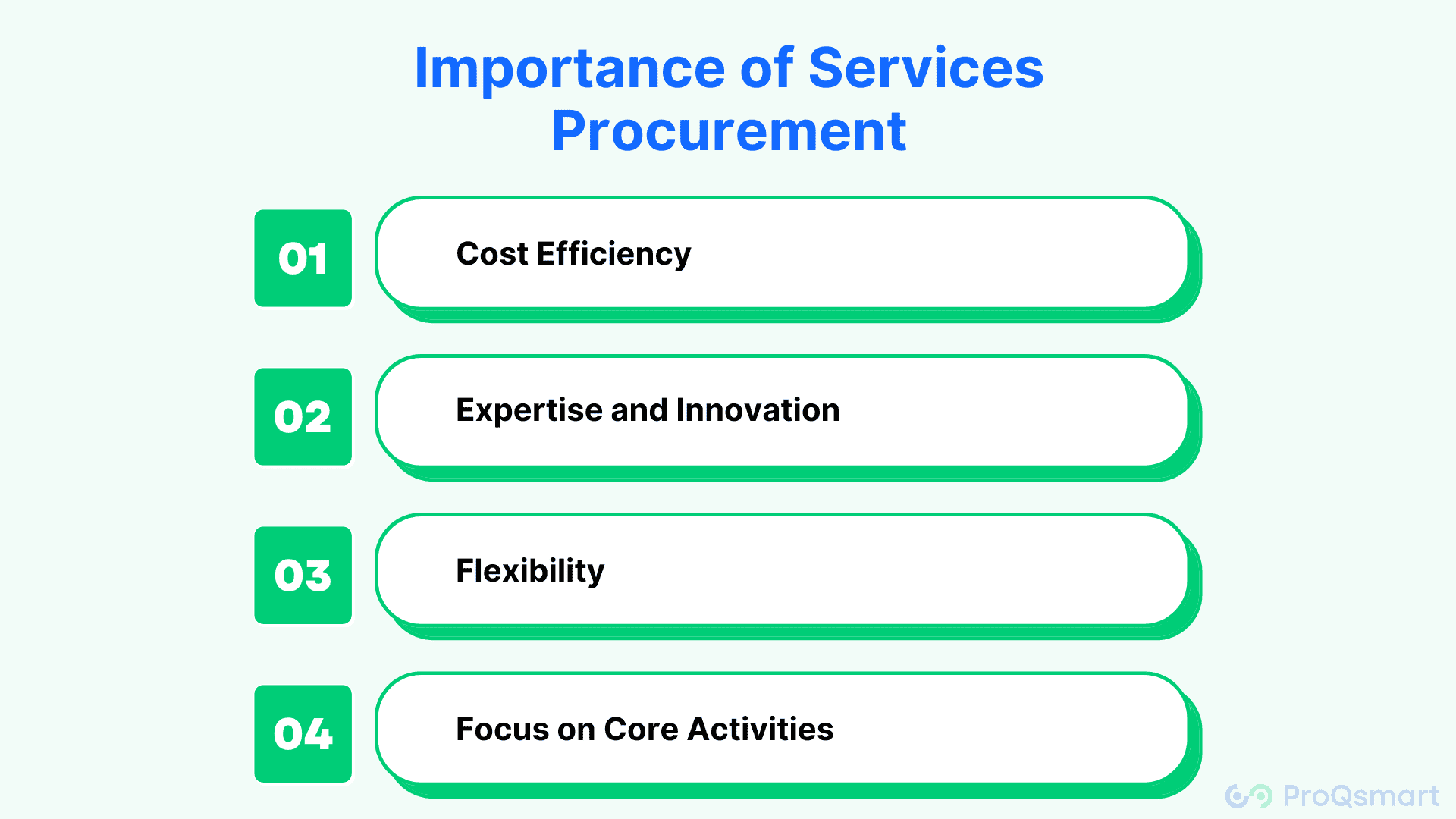In the evolving business landscape, services procurement has become a critical aspect of maintaining operational efficiency and competitive advantage. Unlike goods procurement, which deals with tangible products, services procurement involves sourcing and managing service providers for tasks such as consulting, IT services, marketing, and more. This comprehensive guide will explore the importance of services procurement, its key processes, best practices, and strategies to optimize procurement operations.
What is Services Procurement?
Services procurement is the process of sourcing and managing external service providers to perform specific tasks or projects that support an organization’s operations and strategic objectives. It involves identifying service needs, selecting suitable providers, negotiating contracts, and overseeing service delivery to ensure quality and compliance.
Importance of Services Procurement

- Cost Efficiency: Effective services procurement can lead to significant cost savings by leveraging competitive pricing and optimizing resource allocation.
- Expertise and Innovation: Accessing specialized skills and expertise that may not be available in-house, fostering innovation and improving business outcomes.
- Flexibility: Enhancing organizational flexibility by allowing businesses to scale services up or down based on demand.
- Focus on Core Activities: Enabling businesses to concentrate on their core competencies while outsourcing non-core activities to expert providers.
Key Processes in Services Procurement
Effective services procurement involves several critical processes to ensure the successful acquisition and management of service providers. Here are the key steps:
1. Identifying Service Needs
The first step in services procurement is to identify the specific services required. This involves assessing the organization’s needs, defining the scope of work, and determining the desired outcomes. Clear and detailed requirements help in selecting the right service providers.
2. Supplier Selection
Once the service needs are identified, the next step is to select suitable service providers. This process includes:
- Market Research: Conducting market research to identify potential providers with the necessary expertise and capabilities.
- Request for Proposal (RFP): Issuing an RFP to solicit detailed proposals from interested providers. The RFP should include the scope of work, evaluation criteria, and submission guidelines.
- Evaluation: Evaluating proposals based on predefined criteria such as experience, technical capabilities, pricing, and references. Conducting interviews and site visits may also be part of the evaluation process.
3. Contract Negotiation
Negotiating the contract is a critical step in services procurement. The contract should clearly define the scope of work, deliverables, timelines, pricing, payment terms, and performance metrics. Including clauses for confidentiality, intellectual property rights, and dispute resolution is also essential to protect the organization’s interests.
4. Service Delivery Management
Managing the delivery of services involves monitoring the performance of service providers to ensure they meet the agreed-upon standards and deliverables. This includes regular communication, performance reviews, and addressing any issues or deviations promptly.
5. Performance Evaluation
Regularly evaluating the performance of service providers is crucial for maintaining quality and efficiency. Key performance indicators (KPIs) should be established to measure performance, and feedback should be provided to providers to encourage continuous improvement.
Best Practices for Services Procurement
Adopting best practices in services procurement can significantly enhance the effectiveness and efficiency of the process. Here are some best practices to consider:
1. Develop a Comprehensive Procurement Strategy
A well-defined procurement strategy aligns services procurement with the organization’s overall goals and objectives. It should outline the procurement process, supplier selection criteria, risk management strategies, and performance metrics.
2. Foster Strong Supplier Relationships
Building strong relationships with service providers fosters collaboration and trust. Regular communication, joint problem-solving, and collaborative innovation can lead to improved service levels and cost efficiencies.
3. Leverage Technology
Utilize procurement technology to streamline the services procurement process. E-procurement platforms and procurement software can automate and simplify tasks such as RFP management, contract management, and performance tracking.
4. Conduct Regular Supplier Audits
Performing regular audits of service providers ensures compliance with contractual obligations and industry standards. Audits help identify potential issues early and provide opportunities for corrective actions.
5. Implement Performance-Based Contracts
Using performance-based contracts incentivizes service providers to meet or exceed performance standards. These contracts should include clear performance metrics, penalties for non-compliance, and rewards for exceptional performance.
6. Optimize Cost Management
Effective cost management involves negotiating competitive pricing, monitoring expenditures, and identifying cost-saving opportunities. Regularly reviewing and renegotiating contracts can also help in optimizing costs.
7. Ensure Compliance and Risk Management
Ensuring compliance with legal, regulatory, and industry standards is critical in services procurement. Implementing robust risk management practices helps identify and mitigate potential risks associated with service providers.
Challenges in Services Procurement
Despite its benefits, services procurement can present several challenges. Understanding and addressing these challenges is essential for successful procurement management.
1. Defining Clear Requirements
One of the main challenges is defining clear and precise requirements for the services needed. Ambiguities in the scope of work can lead to misunderstandings and subpar service delivery.
2. Supplier Evaluation and Selection
Selecting the right service provider can be challenging, especially when there are multiple potential providers with varying levels of expertise and pricing. A thorough evaluation process is necessary to make informed decisions.
3. Contract Management
Managing contracts effectively requires attention to detail and ongoing oversight. Ensuring that service providers adhere to contract terms and addressing any issues promptly is crucial.
4. Performance Monitoring
Monitoring the performance of service providers can be complex, particularly for services that are intangible or difficult to quantify. Establishing clear KPIs and regular performance reviews is essential.
5. Risk Management
Managing risks associated with service providers, such as financial stability, compliance, and quality issues, requires proactive risk management strategies.
Case Study: Successful Services Procurement
To illustrate the application of best practices in services procurement, let’s consider a case study of a company that successfully outsourced its IT services.
Background
A mid-sized manufacturing company needed to upgrade its IT infrastructure to support its growing operations. The company decided to outsource its IT services, including network management, cybersecurity, and software development, to a specialized provider.
Steps Taken
- Identifying Service Needs: The company conducted a thorough assessment of its IT requirements, defining the scope of work and desired outcomes.
- Supplier Selection: An RFP was issued, and multiple proposals were received. The company evaluated the proposals based on technical capabilities, experience, pricing, and references. After a detailed evaluation, a reputable IT service provider was selected.
- Contract Negotiation: The contract was negotiated to include detailed service level agreements (SLAs), performance metrics, and terms for confidentiality and intellectual property protection.
- Service Delivery Management: The company established regular communication channels and performance reviews with the IT service provider to monitor progress and address any issues.
- Performance Evaluation: Regular performance evaluations were conducted using predefined KPIs, and feedback was provided to the service provider for continuous improvement.
Outcomes
By following best practices in services procurement, the company successfully upgraded its IT infrastructure, improved system performance, and enhanced cybersecurity. The collaboration with the IT service provider resulted in cost savings and operational efficiencies.
Conclusion
Mastering services procurement is crucial for businesses aiming to enhance operational efficiency and achieve strategic goals. By adopting best practices, leveraging technology, and addressing common challenges, organizations can optimize their services procurement processes and drive long-term success. Implementing a robust services procurement strategy ensures that businesses can access the right expertise, manage costs effectively, and maintain a competitive edge in the market.


